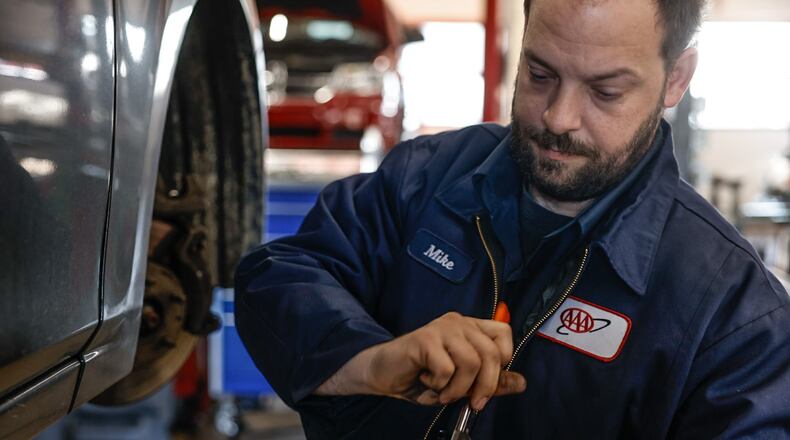Each of the 10 largest auto insurance underwriters raised their premium rates by double digits in 2023, according to the capital market company S&P Global Market Intelligence, compounding previous hikes in 2022.
In Ohio, premiums for auto insurance have gone up at a minimum of 20%, said Dan Scroggins, vice president of personal lines insurance at AAA. In other markets, Scroggins has seen as high as 60% increases.
Nationally, the average cost of full coverage car insurance rose to $2,543 in 2024, an increase of 26% over last year, according to Bankrate, a consumer financial services company.
When combining increases in back-to-back years of 2022 and 2023, Ohio had the second-largest increase cumulative change of 38.9%, according to S&P Global. Texas had the highest cumulative rate increase of 45.5% over the previous two-year period.
Increases to base rates
What drivers pay for car insurance is still primarily based on personal driving history and other factors like the age of the drivers, he said, but some circumstances outside of the drivers’ control are contributing to rate hikes.
“What people are really experiencing right now is an increase in the underlying rate, so that base rate that gets calculated before your personal factors go into,” Scroggins said.
Supply chain issues and inflation are making car parts both expensive and difficult to get, both Scroggins and Wells said.
“Insurance had gone up at lower-than-inflationary levels over the previous decades, so when inflation hit, it was certain to hit insurance,” Scroggins said.
Factors such as driving behavior, driving infractions, vehicle type, claims activity, driving amount, and medical and repair costs impact auto insurance rates, the Ohio Department of Insurance says.
The time it takes for some major repairs to be done to vehicles plays into those increases to the base rate of auto insurance premiums, Scroggins said. That extra time drives up costs as motorists need to use rental cars for longer periods of time while their own cars are out of service.
These hard market conditions have been going on longer than were previously anticipated, Wells said.
Insurance industry experts have seen increases in claim payouts, he said, as the number of natural disasters increase, along with more car accidents taking place since the pandemic.
Social inflation is also blamed as insurers see increasing litigation costs.
“We’re seeing more jurors across the award larger unexpected sums of money at trials,” Wells said.
Is corporate greed also to blame?
Consumer advocates are looking at the large insurance carriers themselves as being partially to blame for cost increases.
The Consumer Federation of America pointed to executive salaries, saying six of the major insurance company CEOs each received more than $12 million in compensation in 2022. The highest was State Farm, which paid its CEO Michael Tipsord more than $24 million in both 2021 and 2022.
The data on executive salaries comes from Nebraska’s Department of Insurance, the Consumer Federation of America said, which requires insurance companies to provide information about the salaries, bonuses and other compensation of their top officials.
“Another reason for auto insurance rates going up is insurer greed and the desire to make big profits,” said Michael DeLong, research and advocacy associate at the Consumer Federation of America.
Rising costs for labor and car parts have gone up, but inflation has gone down, he said.
“During the COVID-19 pandemic, insurance companies earned a lot of money, but they only gave some of that back to consumers, and they didn’t invest the rest wisely,” DeLong said. “They basically spent it on a lot of bonuses for CEOs and dividends and other things for their stockholders.”
What can consumers do for relief?
Rates are unlikely to go back down, Scroggins said, at least not anytime soon.
Still, Ohioans are better off than in neighboring states, he said.
“Ohio is very blessed with many carriers, so carriers can’t just arbitrarily take rate, they have to measure the marketplace and understand what their competitors are doing,” Scroggins said.
To find the best prices, drivers should shop around, industry experts and consumer advocates say.
“In Ohio, we are fortunate to have one of the strongest and most competitive auto insurance marketplaces in the country,” said Todd Walker, director of communications for the Ohio Department of Insurance.
The average auto insurance premium in Ohio historically ranks around the top 10 least expensive, according to the National Association of Insurance Commissioners.
“The first thing you should do is consult with your agent,” Wells said.
Wells’ organization works with independent agents, who can work with multiple insurance carriers to build consumers a package based on their usage needs, he said.
Consumers can contact the Ohio Department of Insurance with any insurance questions at 800-686-1526 or consumer.services@insurance.ohio.gov or by visiting www.insurance.ohio.gov.
About the Author

